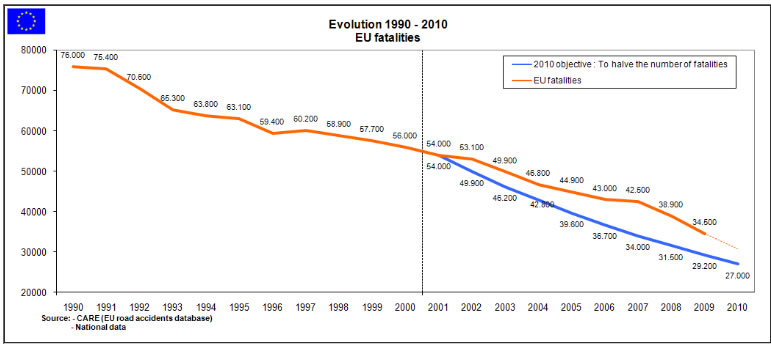6. Road Safety
Link: https://ec.europa.eu/transport/road_safety/index_en.htm
In 2009 around 35,000 people were killed on the roads in Europe.

The good news is that this is half the number of casualties of 1990. The graph above shows that safety measures in the last 20 years have made a huge improvement.
However, the target remains zero casualties and so advances in safety measures will continue. This is partly education efforts to change behaviour and attitudes, such as making drink-driving or use of hand-held mobile phones unacceptable and to persuade people to use safety belts and child seats at all times.
But future technology has a large part to play as well. Such as
Crash avoidance systems
The driver has a split-second to decide on how to avoid a collision.
New collision avoidance systems will sense an approaching accident then apply the brakes automatically as well as warning the driver of danger.
Another system called 'brake support', will sense that the driver is trying to brake hard for some reason and will instantly boost the brake pressure to the maximum possible without skidding, so they stop in the shortest possible distance.
challenge see if you can find out one extra fact on this topic that we haven't already told you
Click on this link: crash avoidance system
Pedestrian safety systems
20% of accidents involve pedestrians.
Modern cars are designed with passive safety such as crumple zones in the bonnet to reduce pedestrian injury and soft foam filled bumpers.
In the future, there will be active systems under the bonnet that will sense an accident then push up the bonnet instantly to increase the clearance between engine and bonnet to minimise head injury.
Another system uses a video camera to sense a pedestrian collision even before they have touched the car. All the safety systems instantly kick in, such as outside air-bag across the wind-screen and bonnet pop-up.
challenge see if you can find out one extra fact on this topic that we haven't already told you
Click on this link: pedestrian safety system
Drowsiness and erratic driving systems
Falling asleep at the wheel is a major cause of accidents, especially on motorways and long stretches of road.
In the future there will be sensors within the car that detect the driver nodding off. These work by monitoring blink rate, eye movement and head position. If the signs are there, then the system will vibrate the wheel to warn the driver. Vibrating in this way is called a 'haptic' interface.
challenge see if you can find out one extra fact on this topic that we haven't already told you
Click on this link: drowsiness sensing system
A common effect of tiredness is to drift across lanes.
There will be lane-sensing systems that detect the drifting car and once again either vibrate the wheel or sound an alarm. These make sophisticated use of pattern recognition and real-time image analysis that is only possible because of powerful on-board processing.
challenge see if you can find out one extra fact on this topic that we haven't already told you
Click on this link: lane assist technology
"Black boxes"
Formally called "Event Data Recorder".
For decades, aircraft have had black boxes fitted that record vital measurements just prior to an accident. In many cases of car accidents, there are no witnesses to let people know what caused the incident.
Now 'black-box' systems are appearing that may be fitted to all future cars. The data recorders store time, speed, steering wheel position, brake pressure and so on. Accident investigators will then have hard data to understand what happened. Car companies may also use this (anonymised) data to improve safety even further.
challenge see if you can find out one extra fact on this topic that we haven't already told you
Click on this link: car black box
Conclusion
The modern car is one of the most sophisticated machines in the world, and it is expected that as new technologies come along such as nano-technology and artificial intelligence, car makers will use them to make journeys even safer and more pleasant.
challenge see if you can find out one extra fact on this topic that we haven't already told you
Click on this link: car safety systems in the future
